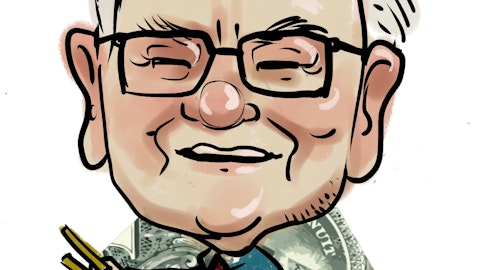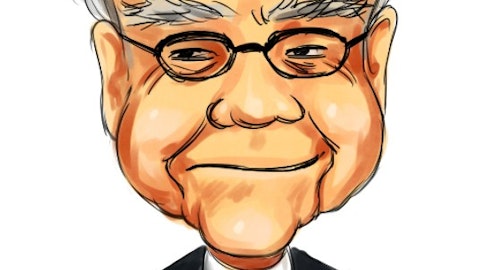No investment clears the bar for me, without a thorough evaluation of the bear case. To turn the process on its head: Without knowing how, why, and where your investment thesis goes wrong, it’s nearly impossible to assess how likely it is to be right.

Color me interested, then, at what Berkshire Hathaway Inc. (NYSE:BRK.A)‘s annual meeting holds. I — along with Inside Value advisor Joe Magyer, Scott Phillips of Fool Australia, Brendan Mathews of MDP and Stock Advisor fame, and Matt Koppenheffer of Fool.com — am headed to this value-investing mecca this weekend. In an attempt to spice up the dialogue around the shareholder Q&A, Buffett has decided to appoint a “qualified bear” — Seabreeze Partners’ Doug Kass — to shoot 10 hardball questions about Berkshire, and the stock, at The Oracle himself. The usual theatrics and sense of camaraderie aside, it adds yet another layer of enjoyment to “Woodstock for Capitalists.” It’s also a testament to Buffett’s transparency.
In the spirit of the debate, here’s my best guess at three potential Kass targets — and, as a happy owner of Berkshire Hathaway Inc. (NYSE:BRK.A) shares, I’ll also offer my rebuttal.
1. Berkshire’s expensive price tag
A commonly bandied-about challenge to owning Berkshire Hathaway Inc. (NYSE:BRK.A) shares is its valuation. There are about 55 ways to value Berkshire and its prospects, but let’s cut through the noise. Keep it simple, stupid.
For a given price, the market expects a certain performance threshold. So, let’s assume that Berkshire is able to grow at just 3%. At 1.4 times book value, we can figure that out pretty easily (via the justified price-to-book) — the market expects Berkshire Hathaway Inc. (NYSE:BRK.A) to earn about 13% returns on equity, and grow its earnings at 3%, in perpetuity. A little perspective: For the 13-year period ended in May 2011, the S&P’s ROE averaged 22%. Now, this measure isn’t without its flaws, and it’s not a perfect apples-to-apples comparison. But, with such tremendous franchises as GEICO, Burlington Northern, MidAmerican, and Lubrizol, do we think it’s possible? Yessir. They’re best-in-class companies, priced as if they’ll generate sub-market returns. Not screaming cheap, but I’ll take that bet.
2. The Elephant Syndrome
The big elephant is the dominant herd member, until its size actually becomes a liability. And so the argument goes that Berkshire Hathaway Inc. (NYSE:BRK.A)’s biggest enemy is itself. It generates too much cash, and has too few opportunities to profitably deploy it. That’s all fine and good, but yet again, a bit of context is in order. Over the past 20 years, investments as a percentage of total assets at Berkshire have declined from 80% to 30%. In essence, we’re paying a lot less for capital redeployed, and more for a collection of splendid operating businesses.
That gets to the other point: Consider Berkshire, the blue-chip private equity. As a consequence of its gilt-edged balance sheet, Berkshire’s endowed with an elephant gun that would make Dwight Eisenhower shiver. Its size has made many investments inconsequential, but it’s opened an entirely different class — which most investors cannot access. This, coupled with it laissez-faire oversight of its operating businesses, make it a logical provider of capital to blue chips seeking capital in times of distress — or managers looking to sell — as it has for H.J. Heinz Company (NYSE:HNZ). Or Burlington Northern Santa Fe. Or Goldman Sachs Group, Inc. (NYSE:GS). My wild-eyed guess on Buffett’s next white whale investment? Mondelez International Inc (NASDAQ:MDLZ). It’s a page straight from Buffett’s playbook, possessing pricing power, scale, and enduring brands.
3. Buffett’s Siren Song
Sad as it is, Buffett won’t run Berkshire Hathaway Inc. (NYSE:BRK.A) one day. And folks posit that returns are likely to suffer, or that it won’t attract the same caliber of operating subsidiary. These things might happen. But it doesn’t seem to me to be as huge an issue as purported. For one, operating businesses are now a very significant contributor to Berkshire’s earnings. Likewise, it could be argued that Berkshire’s most important asset is not Buffett, but its balance sheet. To the extent the right leaders are put in place, and they, too, conduct themselves with integrity and aplomb, the opportunity still exists. Is it a lock? Of course not. But when it comes to business and investing, few things are.
Yet again, a little context: At current prices, we’re paying 17.5 times trailing earnings from Berkshire’s operating businesses. If Berkshire earned just a 3% after-tax return on its $185 billion cash and investments, that number plummets to 11. That’s the long way of saying that Berkshire’s going to be just fine.
In short, I don’t worry too much about Berkshire, and I’m happy to be returning to Omaha for this annual rite of passage, once again. We’ll see those of you that make it there, and for those who can’t, look for Foolish coverage at .
The article The Big, Bad Berkshire Bear originally appeared on Fool.com is written by Michael Olsen, CFA.
Michael Olsen, CFA owns shares of Berkshire Hathaway. The Motley Fool recommends Berkshire Hathaway, Goldman Sachs, and H.J. Heinz Company. The Motley Fool owns shares of Berkshire Hathaway.
Copyright © 1995 – 2013 The Motley Fool, LLC. All rights reserved. The Motley Fool has a disclosure policy.


